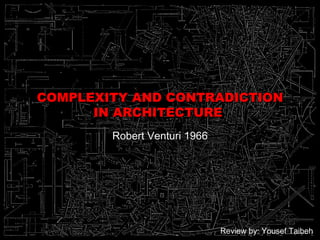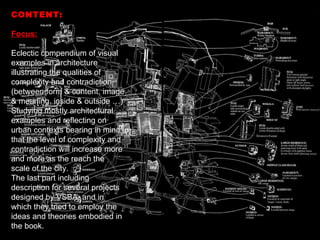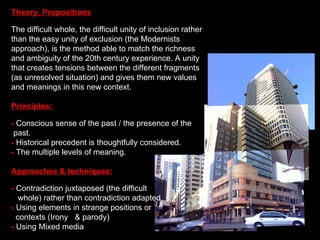Complexity & Contradiction in Architecture
- 1. COMPLEXITY AND CONTRADICTION IN ARCHITECTURE Robert Venturi 1966 Review by: Yousef Taibeh
- 2. INTRODUCTION: - Complexity and Contradiction in Architecture by Robert Venturi 1966 (most of the book was written in 1962) - Published by the Museum of Modern Art (the classical advocate of Modern architecture) - Venturi as a : - Practitioner Architect (graduated from Princeton Uni. In 1947) - Artist (M.F.A from Princeton Uni. In 1950) - Scholar, Author & teacher (Pennsylvania, Yale, Princeton, Harvard, UCLA, Rice and the American Academy in Rome in which previously was a Prize fellow between 1954-56
- 3. THE CONTEXT: The 60s, age of pluralism & revision (a key transitional period) Political conditions: New International Order post WW II, a shift from Europe to America.. Cold war -war of ideologies, warmed up in the 60s (Cuba crisis & outer-space race), as The Economic boom slows dawn. Liberation & individualism civil rights, King & X, Feminists & the pill, the Hippies & the Greens. Conditions in cities: - Post WWII , vast construction project & rebuilding for the destroyed European cities - Modern architecture actualizing the mass production and the social theories. - America getting out of the war unscratched. - Corporate firms adapting the Modern Style. Striped from its original social program. - Modern Architecture proves to be failure in dealing with urban problems or social aspects - Zoning regulations urban renewal& anti-city theories of design added to the problem. - The result is Eroded urban fabrics, dull and dangerous built environments. - Suburbia and other urban sprawls as lived realities.
- 4. Design & planning theory: - The symbolic event of CIAM break up in Late 50s - The emerging new voices critiquing & questioning Modernism (Jacobs, Newman ŌĆ”) - Architectural journals boom supporting the different new schools of thought trying to solve problems of Modernism (the rise of theory). - A series of influential architectural exhibitions.
- 5. Design & planning practice: The Neo-Empiricists (according to Broadbent, recalling: Locke, Berkeley & Hume). Putting Venturi in this category with: - Cullen in Townscapes - Lynch in the image of the city - Alexander in pattern language - Robert Stern - Rowe & Koetter in collage city
- 6. The Wider cultural climate: Academic Architects tried to borrow new thought paradigms from other fields: Arts : Pop arts & its playing on scale and/or context to give new meanings for the ordinary. In addition to the use of mixed media (impurity). Op Art and its richness in complexity and contradiction Surrealism in minimizing the role of the artist
- 7. Science : Gestalt stating that the whole is more than the sum of its parts. & that the same thing in different contexts gives different meaning Phenomenology methods (systematic investigation of consciousness & its object)
- 8. The Death of the Artist
- 9. The Death of the Author
- 10. The Death of the Designer
- 11. The Death of the . . . .
- 12. Linguistics : The general trend to reject the vantage point of the author or subject in favor of the text or the object - Semiotics (Fernand De Saussure & Michel Foucault, Broadbent in architecture) - Structuralism (the true nature of things is in the relationships we construct & then perceive between them)
- 13. CONTENT: Focus: Eclectic compendium of visual examples in architecture illustrating the qualities of complexity and contradiction (between form & content, image & meaning, inside & outside ŌĆ”) Studying mostly architectural examples and reflecting on urban contexts bearing in mind that the level of complexity and contradiction will increase more and more as the reach the scale of the city. The last part including description for several projects designed by VSBA, and in which they tried to employ the ideas and theories embodied in the book.
- 14. Both-And rather than Either-Or Ambiguous rather than Articulated Ordinary rather than Original Compromising rather than Clear Mixed rather than Pure Complex rather than Simple Multiple rather than Monitory Vulgar rather than Heroic Both-And rather than Either-Or Ordinary rather than Original Mixed rather than Pure Multiple rather than Monitory Vulgar rather than Heroic Complex rather than Simple Ordinary rather than Original Ordinary rather than Original Ambiguous rather than Articulated Ordinary rather than Original Distorted rather than Straightforward Vulgar rather than Heroic Multiple rather than Monitory Distorted rather than Straightforward Complex rather than Simple Vulgar rather than Heroic Both-And rather than Either-Or Mixed rather than Pure Vulgar rather than Heroic Vulgar rather than Heroic Both-And rather than Either-Or Ordinary rather than Original Distorted rather than Straightforward Multiple rather than Monitory Ordinary rather than Original Both-And rather than Either-Or
- 15. Theory, Propositions The difficult whole, the difficult unity of inclusion rather than the easy unity of exclusion (the Modernists approach), is the method able to match the richness and ambiguity of the 20th century experience. A unity that creates tensions between the different fragments (as unresolved situation) and gives them new values and meanings in this new context. Principles: - Conscious sense of the past / the presence of the past. - Historical precedent is thoughtfully considered. - The multiple levels of meaning. Approaches & techniques: - Contradiction juxtaposed (the difficult whole) rather than contradiction adapted - Using elements in strange positions or contexts (Irony & parody) - Using Mixed media
- 16. Favored examples, forms & models: The ordinary (even the ugly) rather than the heroic & the original. Everyday landscape, the vulgar and disdained (lesions from Las Vegas -commercial strip, or the suburban town of Levittown -urban sprawl). Double functioning elements The complex architecture of Mannerists, Baroque, Lutyen, even some works of the modernist themselves particularly Le Courbiser, Kahn & Alto (with vitriol towards Mies & Wright)
- 17. ╠²
- 18. Continuing Validity: Vincent Scully while introducing the book compared it to le Corbusier's ŌĆ£Towards a New ArchitectureŌĆØ, hailing it as: " among the few basic texts of our time ŌĆ”, despite its anti-heroic lack of pretension and its shift perspective from the Champs-Elysees to main street". This statement wasn't far from true as Venturi's "gentle manifesto" went through nine re-prints within twenty five year and was translated into sixteen languages. This book is considered to have the founding role (beside Rossi's ŌĆ£the Architecture of the cityŌĆØ) in the rise of Postmodernism and breaking the stranglehold of functionalist thought.


















